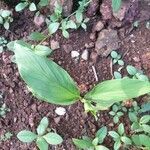| Therapeutic use
|
Anti-inflammatory agents (leaf), Antirheumatic agents (leaf), Edema (leaf), Endophthalmitis (leaf), Fever (leaf), Pain (leaf), Abdominal pain (rhizome), Anthelmintics (rhizome), Anti-bacterial agents (rhizome), Antifungal agents (rhizome), Antipyretics (rhizome), Antirheumatic agents (rhizome), Appetite stimulants (rhizome), Asthma (rhizome), Bronchitis (rhizome), Chest pain (rhizome), Common cold (rhizome), Cough (rhizome), Dandruff (rhizome), Diarrhea (rhizome), Diuretics (rhizome), Dysmenorrhea (rhizome), Dyspepsia (rhizome), Eczema (rhizome), Expectorants (rhizome), Fever (rhizome), Flatulence (rhizome), Halitosis (rhizome), Headache (rhizome), Helminthiasis (rhizome), Hematemesis (rhizome), Hemorrhage (rhizome), Inflammation (rhizome), Insect bites and stings (rhizome), Insecticides (rhizome), Counterirritant (rhizome), Labor pain (rhizome), Leprosy (rhizome), Malaria (rhizome), Neoplasms (rhizome), Nasal disease (rhizome), Pectoralis muscles (rhizome), Psoriasis (rhizome), General tonic for rejuvenation (rhizome), Scabies (rhizome), Skin diseases (rhizome), Skin diseases, infectious (rhizome), Splenic diseases (rhizome), Stomatitis, aphthous (rhizome), Tongue diseases (rhizome), Tonsillitis (rhizome), Toothache (rhizome), Ulcer (rhizome), Urination disorders (rhizome), Urolithiasis (rhizome), Wound healing (rhizome), Wounds and injuries (rhizome), Antineoplastic agents (tuber), Asthma (tuber), Bronchitis (tuber), Cough (tuber), Diuretics (tuber), Expectorants (tuber), Flatulence (tuber), Inflammation (tuber), Mumps (tuber), Nasal disease (tuber), Pectoralis muscles (tuber), General tonic for rejuvenation (tuber), Wounds and injuries (tuber), Abdomen (unspecified), Cancer (unspecified), Carminative (unspecified), Cough (unspecified), Dandruff (unspecified), Diuretic (unspecified), Expectorant (unspecified), Fever (unspecified), Repellant(Insect) (unspecified), Malaria (unspecified), Mastitis (unspecified), Odontalgia (unspecified), Ophthalmia (unspecified), Otosis (unspecified), Pediculicide (unspecified), Perfume (unspecified), Rheumatism (unspecified), Scabies (unspecified), Sore(Throat) (unspecified), Stimulant (unspecified), Stomachic (unspecified), Swelling (unspecified), Toothache (unspecified), Tumor (unspecified), Headache (unspecified), Cosmetic (unspecified), Cicatrizant (unspecified), Chill(Veterinary) (unspecified), Dyspepsia (unspecified), Eye (unspecified), Abdominal pain (unspecified), Allergens (unspecified), Anti-bacterial agents (unspecified), Antifungal agents (unspecified), Antineoplastic agents (unspecified), Antirheumatic agents (unspecified), Appetite stimulants (unspecified), Ascariasis (unspecified), Asthma (unspecified), Cardiotonic agents (unspecified), Digestive system diseases (unspecified), Edema (unspecified), Epilepsy (unspecified), Hemorrhoids (unspecified), Hyperlipidemias (unspecified), Hypertension (unspecified), Insect repellents (unspecified), Insecticides (unspecified), Lung diseases (unspecified), Skin diseases (unspecified), Splenic diseases (unspecified), Wounds and injuries (unspecified), Central nervous system stimulants (unspecified), Liver diseases (whole plant)
|


